Shuttle-Mir Team Members (C - D)
Go
to
Team
Members
Group (A -B)
Go
to
Team
Members
Group (E - G)
Go
to
Team
Members
Group (H - K)
Go
to
Team
Members
Group (L - N)
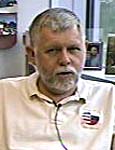 Tommy
E. Capps Profile
Tommy
E. Capps Profile
Tommy Capps was NASA's training manager for Phase 1. As part of his responsibilities, Capps was affiliated with the Phase 1 Crew Training and Exchange Working Group, a group of Americans and Russians who worked together to develop the requirements for crew functions, programs, schedules, and crew training.
As NASA's training manager, Capps oversaw the training of cosmonauts who flew on space shuttles, as well as the Shuttle-Mir and science training the Mir astronauts received. Although his tasks were performed primarily at the Johnson Space Center, Capps traveled to Russia numerous times during the Phase 1 time frame. Capps provides the following description of his job during his Oral History:
"[B]asically what I did is put in place a group of instructors that tailored the training to [the cosmonauts'] needs. We had had a lot of foreign nationals here before and trained them and they worked on the shuttle, but they always came to us with pretty good English skills. They didn't have the cultural differences that we had with the Russians.
"The unique thing for us was learning what the Russian culture was, trying to understand it. They, the same for us. So many things that are a given, [that are] very simple adjustments for a lot of other foreign nationals, [such as] the Japanese, the Europeans, and so forth, were difficult for the Russians. So there was a lot of time and effort in addition to the formal training.
"Our instructors helped them understand how to live here, how to work here, how to understand our approach. But basically we had to develop a training program that was very much tailored to them," said Capps.
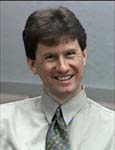 Jeffery
A. Cardenas Profile
Jeffery
A. Cardenas Profile
Jeff Cardenas was NASA's Operations Lead (Ops Lead) in Russia for the Thagard Increment. He coordinated the communications between American-Mir astronaut Norm Thagard, NASA, and Russia from the Russian Mission Control Center (TsUP), located near Moscow.
In the Ops Lead position, Cardenas was in charge of Increment 1's (Thagard's) Mir Operations Support Team, a group of Americans that consisted of an engineer, an operations support tech, a payloads systems engineer, a mission science representative, a biomedical engineer, a flight surgeon, and a public affairs representative. In his Oral History, Cardenas described his tasks for a "typical day" while serving as the first Ops Lead:
"So you try to get there [TsUP] about an hour before the first comm pass, go down and talk to the shift flight directors for that day, see what's happened overnight -- any updates to any of the Mir systems, (or) anything that's impacted negatively -- the events for the day. Go over, kind of script what you're going to say [during the comm pass], because roughly the pass - you've got a morning pass and an evening pass that are dedicated with the American crew members -- so you have roughly about 10 minutes on each pass.
"In some cases you may have to share that time with the [flight] surgeon if there's something that he needs to talk about. Kind of script, go over the day's events with the crew member, any uplink messages that he may have been sent overnight that he should be looking for. Basically you're just trying to give him a thumbnail sketch of what's coming up on the day for that first pass.
"For the rest of the day, usually [you'll be] following what the crew member is doing that day and also preparing for three or four days down the line. For example, if there are new messages that need to go out to tell him how actually to do this experiment, or if it's something associated with the Mir system, those have to be already in process, in work, has to be coordinated, of course, on the Russian side, both from a science and engineering standpoint," Cardenas explained.
Cardenas also participated in the Mir Operations and Integration Working Group (MOIWG). This group coordinated the hardware integration, training, and operations activities of NASA hardware that flew on Russian vehicles. Cardenas worked within the MOIWG as the leader for the Operations and Training Integrated Product Team. In that role, he was responsible for all the mission preparation and execution aspects of implementing the Shuttle-Mir research program. Later, he also served as the co-chair the MOIWG.
Prior to his Shuttle-Mir duties, Cardenas was involved in standalone space shuttle missions, especially those that supported life sciences experiments, such as the Spacelab and International Microgravity Laboratory flights.
Read Jeffrey Cardenas' Oral History
Read about Norm Thagard and NASA-1
Read more about Operations Leads and Russian Interface Officers
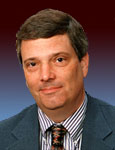 Robert
E. "Bob" Castle Profile
Robert
E. "Bob" Castle Profile
Bob Castle served as a NASA flight director during Phase 1. As a flight director, Castle's responsibilities included the planning, directing, and controlling activities of the space shuttle team during human space flight operations. During a portion of Phase 1, he was the lead for NASA's Mission Operations Directorate. Castle was the lead flight director on STS-71, the first Shuttle-Mir docking mission. In his Oral History, Castle recalled this historic event:
"For me, the whole mission had come together, I think, at the docking. We watched all the docking live [at Johnson Space Center, Mission Control Center]. We had TV of the whole thing. I even had little cross-hairs taped on my TV set at the console so I could see if they were lined up when they came in.
"But when I watched it on TV and the two docking systems came together, I could see on TV the jets firing. The shuttle jets fire to push the two vehicles together. I could see the structure actually rebound. And when it rebounded, it stayed together. The shuttle stayed docked to the Mir. At that point, I felt this enormous almost wall of relief that says, 'Okay, we've got it. This is the hardest part. This is the riskiest part. This is the trickiest part for the whole joint mission. The rest of it, okay, if this mechanism works, it works. If it doesn't work, it doesn't work. Nothing we're going to do about it.'
"But everything that we could do has all come together," he said.
Sharon Castle Profile
Sharon Castle from NASA was the co-chair for the Cargo and Scheduling Subgroup, which was a division within the Management Working Group. This group was responsible for joint manifesting, cargo traffic scheduling, and cargo delivered by the shuttle to the Mir Space Station.
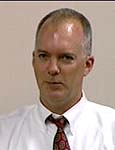 John
B. Charles Profile
John
B. Charles Profile
John Charles, a physiologist, served as NASA's Project Scientist for the human life sciences investigations of Phase 1, Increments 2-7.
Charles was also the mission scientist specifically assigned to the Foale and Linenger Increments, under the lead of Phase 1 Mission Scientist John Uri. As such, Charles was responsible for all science aspects of these missions, including human life sciences, microgravity science, biology, and space sciences.
Additionally, Charles was the cardiovascular discipline lead for the Thagard Increment, and during that flight he became the deputy project scientist for the Thagard science, assisting Peggy Whitson.
In his Oral History, Charles discussed Russian medical data standards: "The Russians have huge databases of people that flew in space and came back warm and pink. If that's what you're looking for, if you're looking for a success, the guy was alive after the flight, they're very good at that. They've got lots and lots of that data.
"But if you're looking at what happened to heart rates, what happened to blood pressures, what happened to certain ion concentrations with time in flight in response to certain provocation, they have almost none of that. In fact, one of the things that the Russian investigators told us is they were glad to see us come along, because they could finally start doing research in flight, because research was the lowest priority.
"So I think the data from the NASA-Mir Program is probably about as good as you're going to get from long-duration space flight on the Mir as anything that the Russians have published," he said.
Charles, a life-long space fan, tailored his education so he could work for NASA. To that end, he has conducted Air Force-funded studies that helped him to understand cardiovascular physiology in extreme environments. These studies also assisted him in learning how to manage large complicated research programs such as he would encounter on Phase 1. Charles holds a Ph.D. from Kentucky State University.
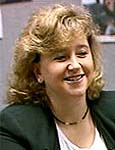 Christine
A. Chiodo Profile
Christine
A. Chiodo Profile
Christine Chiodo served as a backup Operations Lead (Ops Leads) in Russia during Phase 1. She assisted the primary Operations Leads for Increments 3 - 7. Ops leads were responsible for coordinating communications between the US-Mir astronauts, NASA, and Russia from the Russian Mission Control Center (TsUP). They were in charge of an American team in Russia that consisted of an engineer, an operations support tech, a payloads systems engineer, a mission science representative, a biomedical engineer, a flight surgeon, and a public affairs representative.
Chiodo was also a member of the consultant group that went to Russia for STS-71, the first Shuttle-Mir docking mission, which is the trip that sparked her interest in working as an Ops Lead. In her Oral History, Chiodo described her roles as an Ops Lead:
"We managed a team of folks to kind of be the eyes and ears for the astronauts on board. It involved things like keeping them up-to-date on what their schedule was going to include, any changes to activities, changes to experiments, passing information about experiments back to the payload developers, taking care of scheduling press events, things like that.
"So it was a little bit of everything over there. We also talked with the astronauts a couple times a day, just trying to keep them up-to-date on what was going on in the world, both within NASA and outside of places," she said.
Prior to her Phase 1 duties, Chiodo was a Space Shuttle Flight Activities Officer, or FAO, a mission control console position involving the development of the crew timelines for shuttle missions.
Read
Christine Chiodo's Oral History
Read
more about Operations Leads and Russian Interface Officers
Tom E. Cremins Profile
Tom Cremins served as NASA's Deputy Assistant to the Director for Human Space Flight Programs, Russia. He joined NASA in 1993 as a Russian affairs program analyst in the Office of Space Flight at NASA Headquarters. In May of 1994, he transferred to the Johnson Space Center in Houston, where he has held progressively responsible positions supporting Russian space flight programs.
Cremins has a bachelor of arts degree in International Relations. Prior to his NASA career and a master's degree in International Science and Technical Policy. In his Oral History, Cremins comments on the reasons for establishing the Phase 1 Program:
"[A]ll the flights and [the U.S.] starting to pay for some of that activity -- a lot of that was directly related to trying to discourage Russian scientists and engineers from leaving the country and working for folks that didn't necessarily have a global interest or a good global interest, as well as to discourage some sales that were going on at that time of rocket technology [by Russia] to India that we [U.S] were uncomfortable with. . . [Plus trying] to create a positive venue for Russia and us to be working in, in a non-threatening manner.
"So that was really what generated, I think, at the top level, generated a lot of the support for doing the flights to Mir. But there's a lot of levels to ità. It was [also] a way to have a destination for the shuttle and to give early experience [for the International Space Station]."
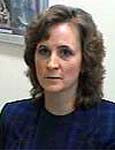 Sally
P. Davis Profile
Sally
P. Davis Profile
Sally Davis was a Russian Interface Officer (RIO) for the Phase 1 Program, responsible for coordinating the communications between the Mission Control Center at the NASA Johnson Space Center in Houston, Texas, and the Russian Mission Control Center (TsUP) near Moscow. Davis served as the RIO for STS-71, STS-74, and STS-76.
The job of a RIO was established during the Phase 1 Program. Davis describes the duties of this role in her Oral History:
"The way I remember it, there were a lot of different versions of what the RIO was going to be, everything from assistant flight director to just somebody that's mimicking what everybody else tells them. In reality, the job wound up being something in between, trying to be as cognizant as you could of what was going on in the flight control team and figuring out which of that we should tell the Russians. Not to withhold information, but that it wasn't relevant to their decision-making processes. And then to do the reverse.
"They [Russians] had a person in their control center that was doing the same thing, which was aide to the flight director. The Russian acronym was PRP. So you'd have to take what he told you and figure out the relevance to the decisions that we were making in the control center and then pass those along to either the flight director or the appropriate person on the flight control team.
"It [the RIO position] was a way to simplify the interface between the two control teams. . . you need somebody that's going to keep each control center in sync, because you can go off 40 directions with everybody doing their same thing. You have that problem anyway with one flight control team.
"So with two [flight control teams], you needed, I guess you'd call it a sync pulse. Keep the control teams in line. That's kind of what the RIO and the PRP did."
Davis has also worked as a Rendezvous Guidance Procedures Officer and performed that function together with her RIO duties during STS-71, the first docking of the Space Shuttle Atlantis to the Russian Space Station Mir.
She has also held the position of flight design manager, which is the person who coordinates putting together the trajectory and the consumables required to do a flight, including launch window determination, and rendezvous and entry design. While she was a flight design manager, Davis made several trips to Russia with a team to look at the feasibility of docking the shuttle to the Mir.
During her RIO work, Davis was selected to become a flight director.
Read
Sally Davis' Oral History
Read
more about Operations Leads and Russian Interface Officers
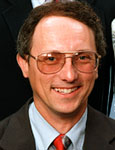 Paul
F. Dye Profile
Paul
F. Dye Profile
Paul Dye was NASA's lead flight director for three Phase 1 missions: STS-79, STS-86, and STS-91. As a flight director, Dye was responsible for planning, directing, and controlling the activities of the space shuttle team during these human space flight operations.
Prior to Phase 1, Dye was a section head in the Mechanical Systems Section of NASA's Systems Division, where he worked with spacecraft systems. During this time, he was a member of a team that traveled to Russia to ascertain the feasibility of docking the shuttle to the Mir.
Dye made a number of subsequent trips to Russia to support Phase 1 activities. While on one of his trips to Russia, he was in the Russian Mission Control Center when the Spektr was rammed June 25, 1997, by the Progress resupply ship.
In his Oral History, Dye commented on being a flight director. The following remarks focus on one aspect of what might happen as the team approaches a launch date:
"You never really relax when you're flying with a big spacecraft and you're responsible for half a million pounds of spacecraft up there, but I think the more tense times come, for instance, in the last two weeks before flight.
"We have something that we talk about, that was described to me when I came here. I wasn't here for Apollo, but it was described to me as the 'burning rocks syndrome.' People tend to keep little problems in the back of their minds until they get really close to flight, and they can't stand it anymore and they have to bring those issues up.
"It's called 'burning rocks' because apparently just before the Apollo 11 Moon landing, some scientist, who was well respected in his field said, 'I'm really afraid that when the lunar module engine touches the Moon, that it could be the wrong composition of chemicals and the Moon might explode.' And, of course, he brought this up a couple of hours before powered descent. Well, [I'm sure the flight director thought], thank you very much, but couldn't you have told me about this before we went to the Moon? Now what do I do with this problem?"
Go
to Team Members group (A - B)
Go
to Team Members group (E - G)
Go
to Team Members group (H - K)
Go
to Team Members group (L - N)